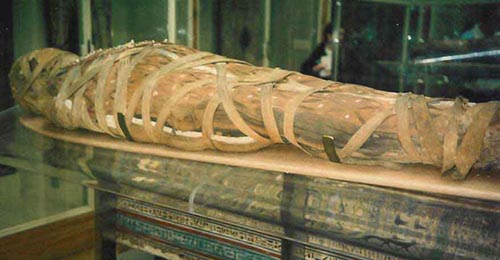Current event: http://www.ancient-origins.net/news-general/modern-version-ancient-egyptian-practice-mummification-now-available-001354
http://science.howstuffworks.com/mummy5.htm
Past event: http://en.wikipedia.org/wiki/Ancient_Egyptian_burial_customs
http://science.howstuffworks.com/mummy5.htm
Past event: http://en.wikipedia.org/wiki/Ancient_Egyptian_burial_customs
"Comparing Ancient Egyptian With Modern Mummification Techniques"
Modern ways of mummification replace the fluids in the body with something that won't decay. The idea is to preserve the body so that thousands of years from now it will look exactly like the way it did when the person died . One modern process claims to be similar to Egyptian techniques and takes 120 days. First organs are removed and cleansed then the body is submerged for 70 days in a tank of preservation solution made up of chemicals. The organs are then reinserted and the body is preserved in a plastic resin. It is covered with lanolin and wax followed by layers of cotton gauze and a fiber glass finish. The body is then encased in steel or bronze casket. The coffin is then put into a tomb with other mummies. Another modern technique replaces the fluids and tissues with wax and plastics.
The main process of mummification during ancient times was preserving the body by dehydrating it using natron, a natural material found in Wadi Natron. Natron is like a combination of baking soda and salt. The body is drained of any liquids but the skin, hair and muscles are preserved. The most classic and common method of mummification dates back to the 18th Dynasty. The fist step was to remove the liquids so that the body would not decay. The next step was to remove the internal organs, the lungs, liver, stomach, and intestines, and place them in the canopic jars with lids shaped like head of the protective gods. Then the body was washed with wine and stuffed with bags of natron. The dehydration process took 40 days and removing the organs took about 30 days. The body was then covered with dressing which provided physical protection. Wealthier mummies had a burial mask of their head.
The main goal of all types of mummification is to preserve the body so it won't decay. The Egyptian way of mummification was the opposite of modern mummification, because during ancient times the body was dehydrated and nothing replaced the lost fluids. While in modern day mummification the body is dehydrated but the lost fluids are replaced by preservative fluids, wax or plastic resin. The result of ancient mummification techniques were not very realistic. The mummies were unrecognizable. Modern mummification produces a more realistic figure. The chemicals used today really help the mummy look like the dead person. Modern embalmers have many more chemical and techniques than the Egyptians available for making a realistic representation of the body.
The main process of mummification during ancient times was preserving the body by dehydrating it using natron, a natural material found in Wadi Natron. Natron is like a combination of baking soda and salt. The body is drained of any liquids but the skin, hair and muscles are preserved. The most classic and common method of mummification dates back to the 18th Dynasty. The fist step was to remove the liquids so that the body would not decay. The next step was to remove the internal organs, the lungs, liver, stomach, and intestines, and place them in the canopic jars with lids shaped like head of the protective gods. Then the body was washed with wine and stuffed with bags of natron. The dehydration process took 40 days and removing the organs took about 30 days. The body was then covered with dressing which provided physical protection. Wealthier mummies had a burial mask of their head.
The main goal of all types of mummification is to preserve the body so it won't decay. The Egyptian way of mummification was the opposite of modern mummification, because during ancient times the body was dehydrated and nothing replaced the lost fluids. While in modern day mummification the body is dehydrated but the lost fluids are replaced by preservative fluids, wax or plastic resin. The result of ancient mummification techniques were not very realistic. The mummies were unrecognizable. Modern mummification produces a more realistic figure. The chemicals used today really help the mummy look like the dead person. Modern embalmers have many more chemical and techniques than the Egyptians available for making a realistic representation of the body.


Citations:
- http://www.sciencebuddies.org/Files/3598/5/HumBio_img014.jpg
- http://i-cias.com/e.o/slides/mummy01.jpg
Current Event Article:
Modern version of ancient Egyptian practice of mummification
18 February, 2014 - 01:13 aprilholloway
Link: http://www.ancient-origins.net/news-general/modern-version-ancient-egyptian-practice-mummification-now-available-001354
Ancient Article:
Archeology: The Milk Revolution
Wikipedia
Link:http://en.wikipedia.org/wiki/Ancient_Egyptian_burial_customs
No comments:
Post a Comment